#battleofapachepass
Explore tagged Tumblr posts
Text

Chief Augustin Vigil of the Jicarilla Apache
~
Circa 1880
#augustinvigil#jicarillaapche#warmspringsapache#1880s#battleofapachepass#apachewars#arizona#newmexico#mexico
4 notes
·
View notes
Text

Geronimo and his two nieces standing next to him
~
Chiricahua Apache, circa early 1900s.
#battleofapachepass#apachewars#mexico#newmexico#arizona#nativeamericans#trueamerican#20thcentury#19thcentury#warmspringsapache#chiricahuaapache#Bedonkohe#geronimo#mangascoloradas#baishan#cochise#taza#naiche#nana#perico#juh#victorio#lozen#apachekid#dutchy#alchesay#chato#bonito#sanjuan#chiefchihuahua
1 note
·
View note
Text

Buffalo Calf
~
Jicarilla Apache nation, circa 1880
0 notes
Text

No-talq, circa 1883
~
Chiricahua Apache
#notalq#No-Talq#arizona#newmexico#apache#chiricahua#warmspringsapache#1883#1880s#19thcentury#apachewars#battleofapachepass#nativeamericans#trueamerican#firstamericans
6 notes
·
View notes
Text
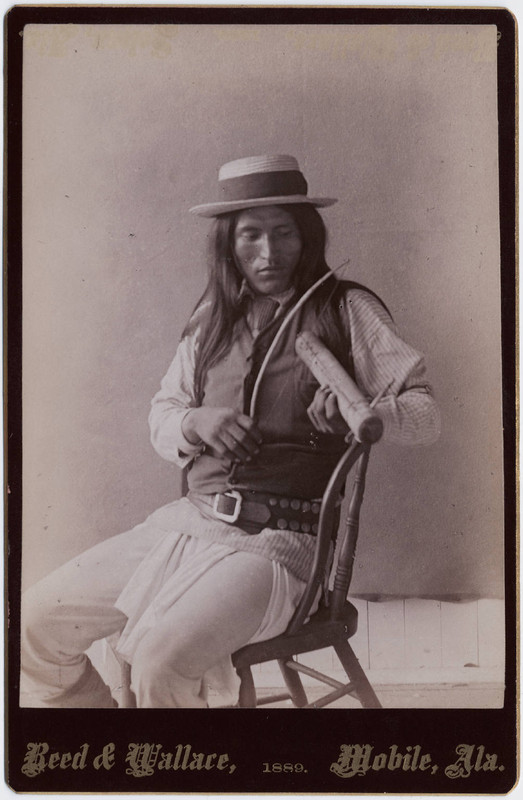
Yanozha; Chiricahua Apache
~
Taken in Florida, circa 1885
#trueamericans
#Yanozha#florida#chiricahua#apache#warmspringsapache#battleofapachepass#apachewars#1885#1880s#mescalero#tontoapache#jicarilla#plainsapache#mangascoloradas#cochise#taza#naiche#victorio#lozen#nana#loco#chato#geronimo#juh#dutchy#apachekid#bonito#baishan#sanjuan#nativeamericans
8 notes
·
View notes
Text
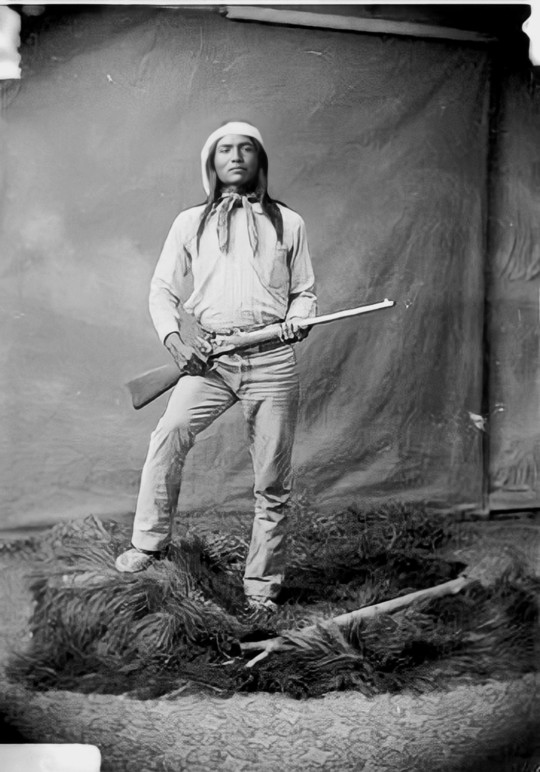
Haskay-bay-nay-ntayl
Haskay-bay-nay-ntayl, more commonly known as Apache Kid, was a White Mountain Apache who was captured by the Yuma people as a child, who was later freed by the U.S. Army where he became a street orphan within the Army camps. In the mid-1870s when he was a teenager, Haskay-bay-nay-ntayl met Al Sieber and was essentially adopted by him, the Chief of the Army Scouts. A few years later, in 1881, Haskay-bay-nay-ntayl enlisted with the U.S. Cavalry as an Indian scout, in a program designed by General George Crook to help quell raids by hostile bands of Apache. By July 1882, owing to his remarkable abilities in the job, he was promoted to sergeant. Shortly thereafter he accompanied Crook on an expedition into the Sierra Madre Occidental. He worked on assignment both in Arizona and northern Mexico over the next couple of years, but in 1885 he was involved in a riot while intoxicated, and to prevent him being hanged by Mexican authorities, Sieber sent him back north.
#theapachekid#Haskay-bay-nay-ntayl#chiricahua#apache#apachescout#apachewars#battleofapachepass#nativeamericans#trueamerican#19thcentury#warmspringsapache#jicarillaapache#victorio#lozen#geronimo#dutchy#juh#bonito#blackknife#ponce#sanjuan#mangascoloradas#nana#cochise#naiche#chato#chiefchihuahua#chiefjamesgarfield
9 notes
·
View notes
Text
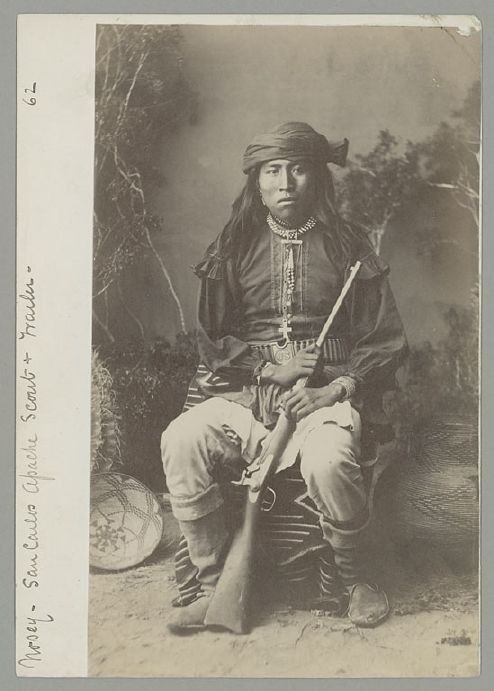
Nosey; San Carlos Apache scout
#nosey#sancarlosapache#apachescout#battleofapachepass#apachewars#arizona#newmexico#mexico#loco#baishan#mangascoloradas#cochise#taza#naiche#nana#victorio#lozen#perico#chato#alchesay#chiefchihuahua#apachekid#dutchy#sanjuan#juh#geronimo#chiefjamesgarfield#nativeamericans#trueamerican#19thcentury
6 notes
·
View notes
Text

A young Mescalero Apache boy holding a mirror in his left hand
~
Circa 1888
#mescaleroapache#1888#1880s#battleofapachepass#apachewars#baishan#mangascoloradas#cochise#taza#naiche#victorio#lozen#nana#geronimo#perico#fun#alchesay#dutchy#apachekid#bonito#sanjuan#juh#chato#chiefchihuahua#chiefjamesgarfield
2 notes
·
View notes
Text
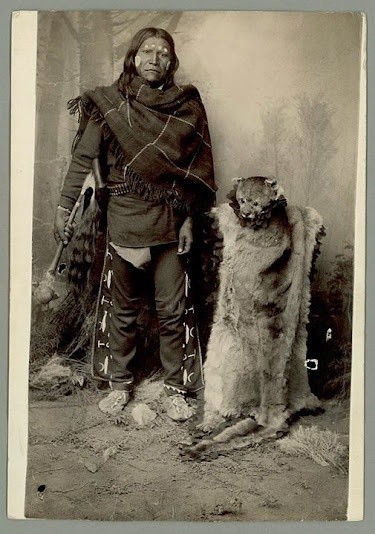
Domingo; Mescalero Apache
~
Circa 1885
#domingo#mescalero#warmspringsapache#sancarlosapache#tontoapache#jicarilla#chiricahua#battleofapachepass#apachewars#sanjuan#bonito#juh#loco#dutchy#baishan#mangascoloradas#cochise#taza#naiche#nana#victorio#lozen#geronimo#apachekid#chiefchihuahua#alchesay#perico#nativeamericans#trueamerican#19thcentury
6 notes
·
View notes
Text

Chiricahua Apache boy
~
Circa 1888
#chiricahua#apache#warmspringsapache#arizona#newmexico#1880s#battleofapachepass#apachewars#geronimo#baishan#mangascoloradas#cochise#taza#naiche#victorio#lozen#nana#loco#alchesay#perico#chato#chiefchihuahua#sanjuan#juh#apachekid#dutchy#bonito#nativeamericans#trueamerican#19thcentury
2 notes
·
View notes
Text

Notchi more known as George Noche, Chiricahua Apache
~
Circa 1886
#noche#notchi#warmspringsapache#chiricahua#apache#apachewars#battleofapachepass#mangascoloradas#geronimo#victorio#lozen
3 notes
·
View notes
Text

Chato, Subchief of the Chiricahua Apache
~
Circa 1903
#chato#chiricahuaapache#nativeamericans#trueamericans#19thcentury#apachewars#mexico#battleofapachepass#geronimo#loco#victorio#lozen#blackknife#chiefchihuahua#nana#cochise#naiche#mangascoloradas#ponce#theapachekid#dutchy#warmspringsapache
3 notes
·
View notes
Text

Chasi, a Chiricahua Apache musician playing the fiddle
~
Circa 1886
#chasi#chiricahua#apache#warmspringsapache#arizona#newmexico#1886#1880s#battleofapachepass#apachewars#apachekid#dutchy#bonito#juh#sanjuan#chiefchihuahua#loco#perico#alchesay#chato#geronimo#baishan#cochise#taza#naiche#victorio#lozen#nana#chiefjamesgarfield#nativeamericans
2 notes
·
View notes
Text

Chief Baishan, circa 1846
Baishan, son of the famed Chief Fuerte, also known as Soldato Fiero, was a most respected war leader among the Tchihende bands along almost three decades from the beginning of 1830s, and the principal chief the Warm Springs local group of the Tchihende (Mimbreño) Apaches after Fuerte's death in 1837 near Janos; he was also the second principal chief of the whole Tchihende Apaches after his long-time companion (and possibly brother-in-law) Mangas Coloradas, chief of the Coppermine local group of the same Tchihende Apaches. His name was translated by the Mexicans as Cuchillo or Cuchillo Negro, because of the Apache practice of blackening their weapons to make them less conspicuous. About 1835, Fuerte, chief of the Warmspring Mimbreño Apache, was killed near Santa Rita del Cobre by Mexican troops belonging to the garrison of Janos, but Juan José Compa, the old leader of the Coppermine Mimbreño Apaches who was friendly to the Mexicans, rejected Baishan's request of help to assault and destroy Santa Rita; Baishan led a bloody raid to Sonora. After Juan José Compa too was killed for bounty money in 1837 in the massacre at Santa Rita del Cobre, Baishan joined Mangas Coloradas in his revenge, the two chiefs operating a series of retaliatory raids against the Mexicans, killing and destroying all around the mining town and placing Santa Rita under siege, finally attacking the column of fleeing Mexicans and slaughtering a large number. In he was falsely claimed to have been killed by Mexican troops in the Oputo Mountains. In 1847, to revenge the Galeana massacre, Baishan called a council with the Tchihende (Mimbreño), Tsokanende (Chiricahua) and Ndendahe (Mogollon) chiefs. Late in that autumn he, Mangas Coloradas, and, probably, the Tsokanende leaders Miguel Narbona, Tapilà and Yrigollen went to raid Chihuahua with 200 warriors, occupying Ramos, near Janos, and killing most of the inhabitants. In 1848 Mangas Coloradas and Baishan with their Mimbreños, and Miguel Narbona and Yrigollen with their Chiricahuas, attacked Sonora, and on February 18 they burned Chinapa, killing or capturing many Mexicans. Baishan's name is mentioned in military and civilian records of treaties and other dealings with Apaches during the early years of U.S. jurisdiction over the New Mexico Territory. In 1851 the settlement at Santa Rita del Cobre of the U.S. delegation (with General J.R. Bartlett) in the Mexican-American Border Commission and the reopening of the Santa Rita del Cobre copper mines effected a meeting with the Anglo-American newcomers; and Baishan, just as Mangas Coloradas, Delgadito, Ponce, Coleto Amarillo and all the most important Tchihende and Ndendahe chiefs, had to face new problems. In June 1851 Mangas Coloradas, with Delgadito, Ponce and Coleto Amarillo, went to Santa Rita del Cobre to meet General Bartlett. The discussions went on until the Apaches no longer felt themselves disappointed and betrayed by the newcomers. Baishan, too, had to face some problems in connection with some young Mexican boys who had been adopted into his band. In 1853, along with Ponce, Delgadito and Victorio, he signed a treaty in Fort Webster with Indian agent Edward H. Wingfield, who had been sent by the governor of the New Mexico Territory, William Carr Lane.
#Baishan#blackknife#Mimbreños#Tchihende#apache#apachewars#battleofapachepass#newmexico#mexico#mangascoloras#loco#victorio#lozen#geronimo#cochise#naiche#nana#sanjuan#chiefchihuahua#trueamerican#nativeamericans#19thcentury#warmspringsapache
5 notes
·
View notes
Text
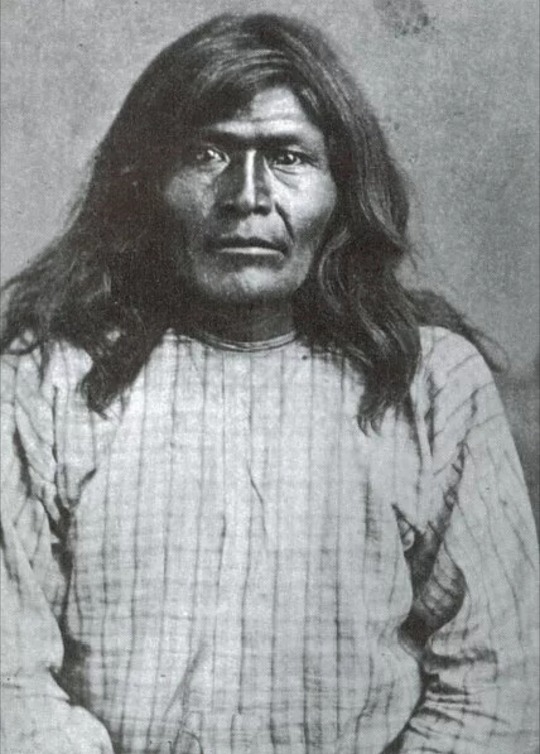
Victorio
Bidu-ya, more commonly known as Victorio, was a warrior and chief of the Warm Springs band of the Tchihendeh (or Chiricahua, often called Mimbreño) division of the central Apaches in what is now the American states of Texas, New Mexico, Arizona, and the Mexican states of Sonora and Chihuahua. Victorio was born in the Black Range of New Mexico in 1825. Victorio was raised as a member of the Eastern Chihenne Apache, also known as the Warm Springs and Mimbreno Apache. There is speculation that he or his band had Navajo kinship ties and was known among the Navajo as "he who checks his horse". Victorio's sister was the famous woman warrior Lozen; "Dextrous Horse Thief". In 1853 he was considered a chief or sub-chief by the United States Army and signed a document. In his twenties, he rode with Mangas Coloradas, leader of the Coppermine band of the Tchihendeh people and principal leader of the whole Tchihendeh Apache division (who took him as his son-in-law), and Cuchillo Negro, leader of the Warm Springs band of the Tchihendeh people and second principal leader of the whole Tchihendeh Apache division, as well as did Nana, Delgadito, Cochise, Juh, Geronimo and other Apache leaders. Mangas Coloradas taught Victorio how to create an ambush and to wait for enemies to enter the killing zone.[1] As was the custom, he became the leader of a large mixed band of Mimbreños and Mescaleros (led by his friend – and probably brother-in-law as husband of another daughter of Mangas Coloradas, as well Cochise) and fought against the United States Army. From 1870 to 1880, Victorio, chief of the Coppermine Mimbreños and principal leader of all the Tchihende, along with Loco, chief of the Warm Spring Mimbreños and second-ranking among the Tchihende, were moved to and left at least three different reservations, some more than once, despite their bands' request to live on traditional lands. Victorio, Loco and the Mimbreños were moved to San Carlos Reservation in Arizona Territory in 1877. Victorio and his followers (including old Nana) left the reservation twice, seeking and temporarily obtaining hospitality in Fort Stanton Reservation among their Sierra Blanca and Sacramento Mescalero allies and relatives (Caballero was probably Victorio's brother-in-law and Mangus' uncle, San Juan was too an old friend and Nana's wife was a Mescalero woman), before they came back to Ojo Caliente only to leave permanently in late August 1879, which started Victorio's War. Despite Nautzili's efforts, many Northern Mescalero warriors, led by Caballero and Muchacho Negro, joined him with their families, and San Juan and other Mescaleros also left their reservation; many Guadalupe and Limpia Mescalero too (Carnoviste and Alsate were close allies to Victorio after 1874) joined Victorio's people. Victorio was successful at raiding and evading capture by the military, and won a significant engagement at Las Animas Canyon in what is now the Aldo Leopold Wilderness on September 18 1879. In Victorio's War from September 1879 to October 1880, Victorio led a band of Apaches, never numbering more than 200 men, in a running battle with the U.S. and Mexican armies and the civilian population of New Mexico, Texas, and northern Mexico, fighting two dozen skirmishes and battles. In October 1880, in north-eastern Chihuahua (a land well-known to the Guadalupe and Limpia Southern Mescaleros), having sent Nana and Mangus to raid for food and ammunition, Victorio, with only a few warriors and even less ammunition, his band were surrounded and sadly, were murdered by soldiers of the Mexican Army under Colonel Joaquin.
#nativeamerican#apache#chiricahua#19thcentury#victorio#lozen#apachewars#battleofapachepass#trueamericans#warmspringsapache
3 notes
·
View notes
Text

Guerito, known also as Man With Yellow Hair; Jicarilla Apache
~
Circa 1880
#Guerito#manwithyellowhair#jicarillaapache#1880s#1880#arizona#newmexico#battleofapachepass#apachewars#geronimo#baishan#mangascoloradas#cochise#taza#naiche
3 notes
·
View notes